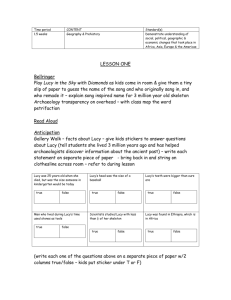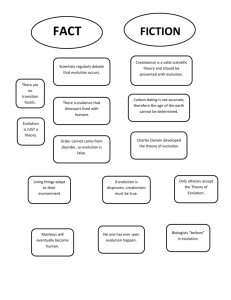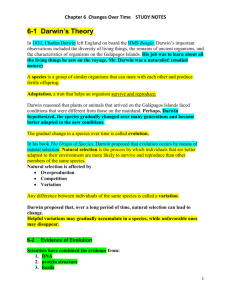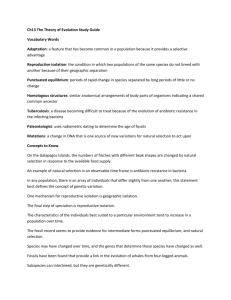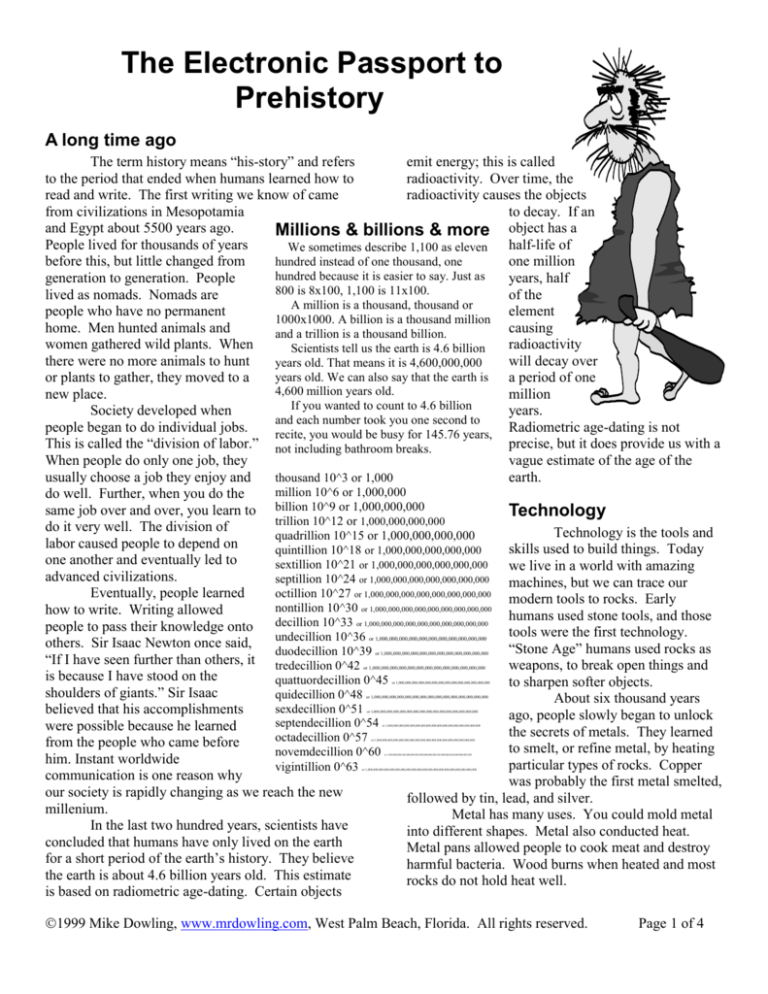
The Electronic Passport to
Prehistory
A long time ago
The term history means “his-story” and refers
emit energy; this is called
to the period that ended when humans learned how to
radioactivity. Over time, the
read and write. The first writing we know of came
radioactivity causes the objects
from civilizations in Mesopotamia
to decay. If an
and Egypt about 5500 years ago.
Millions & billions & more object has a
People lived for thousands of years
half-life of
We sometimes describe 1,100 as eleven
hundred
instead
of
one
thousand,
one
before this, but little changed from
one million
hundred because it is easier to say. Just as
generation to generation. People
years, half
800 is 8x100, 1,100 is 11x100.
lived as nomads. Nomads are
of the
A million is a thousand, thousand or
people who have no permanent
element
1000x1000. A billion is a thousand million
home. Men hunted animals and
causing
and a trillion is a thousand billion.
women gathered wild plants. When
radioactivity
Scientists tell us the earth is 4.6 billion
there were no more animals to hunt
will decay over
years old. That means it is 4,600,000,000
years
old.
We
can
also
say
that
the
earth
is
or plants to gather, they moved to a
a period of one
4,600 million years old.
new place.
million
If you wanted to count to 4.6 billion
Society developed when
years.
and each number took you one second to
people began to do individual jobs.
Radiometric age-dating is not
recite, you would be busy for 145.76 years,
This is called the “division of labor.” not including bathroom breaks.
precise, but it does provide us with a
When people do only one job, they
vague estimate of the age of the
usually choose a job they enjoy and
earth.
thousand 10^3 or 1,000
million 10^6 or 1,000,000
do well. Further, when you do the
same job over and over, you learn to billion 10^9 or 1,000,000,000
Technology
trillion 10^12 or 1,000,000,000,000
do it very well. The division of
Technology is the tools and
quadrillion 10^15 or 1,000,000,000,000
labor caused people to depend on
skills used to build things. Today
quintillion 10^18 or 1,000,000,000,000,000
one another and eventually led to
sextillion 10^21 or 1,000,000,000,000,000,000
we live in a world with amazing
advanced civilizations.
septillion 10^24 or 1,000,000,000,000,000,000,000
machines, but we can trace our
octillion 10^27 or 1,000,000,000,000,000,000,000,000 modern tools to rocks. Early
Eventually, people learned
nontillion 10^30 or 1,000,000,000,000,000,000,000,000,000
how to write. Writing allowed
humans used stone tools, and those
decillion 10^33 or 1,000,000,000,000,000,000,000,000,000,000
people to pass their knowledge onto
tools were the first technology.
undecillion 10^36
others. Sir Isaac Newton once said,
“Stone Age” humans used rocks as
duodecillion 10^39
“If I have seen further than others, it tredecillion 0^42
weapons, to break open things and
is because I have stood on the
quattuordecillion 0^45
to sharpen softer objects.
shoulders of giants.” Sir Isaac
quidecillion 0^48
About six thousand years
sexdecillion 0^51
believed that his accomplishments
ago, people slowly began to unlock
septendecillion 0^54
were possible because he learned
the secrets of metals. They learned
octadecillion 0^57
from the people who came before
to smelt, or refine metal, by heating
novemdecillion 0^60
him. Instant worldwide
particular types of rocks. Copper
vigintillion 0^63
communication is one reason why
was probably the first metal smelted,
our society is rapidly changing as we reach the new
followed by tin, lead, and silver.
millenium.
Metal has many uses. You could mold metal
In the last two hundred years, scientists have
into different shapes. Metal also conducted heat.
concluded that humans have only lived on the earth
Metal pans allowed people to cook meat and destroy
for a short period of the earth’s history. They believe
harmful bacteria. Wood burns when heated and most
the earth is about 4.6 billion years old. This estimate
rocks do not hold heat well.
is based on radiometric age-dating. Certain objects
or 1,000,000,000,000,000,000,000,000,000,000,000
or 1,000,000,000,000,000,000,000,000,000,000,000,000
or 1,000,000,000,000,000,000,000,000,000,000,000,000,000
or 1,000,000,000,000,000,000,000,000,000,000,000,000,000,000
or 1,000,000,000,000,000,000,000,000,000,000,000,000,000,000,000
or 1,000,000,000,000,000,000,000,000,000,000,000,000,000,000,000,000
or 1,000,000,000,000,000,000,000,000,000,000,000,000,000,000,000,000,000
or 1,000,000,000,000,000,000,000,000,000,000,000,000,000,000,000,000,000,000
or 1,000,000,000,000,000,000,000,000,000,000,000,000,000,000,000,000,000,000,000
or 1,000,000,000,000,000,000,000,000,000,000,000,000,000,000,000,000,000,000,000,000
1999 Mike Dowling, www.mrdowling.com, West Palm Beach, Florida. All rights reserved.
Page 1 of 4
Iron was the most important metal to early
cultures. People used the knowledge of iron to
conquer others. The discovery of iron made
it possible for the advancement of many
civilizations in different parts of the
world.
Theories
Most of what we study is
based on facts, but scientists have
to make educated guesses about
prehistory. We call these guesses
theories. Theories about prehistory
often change as we make new
discoveries about the past.
Many cultures and religious faiths have
creation stories. Some—but not all—Christians
believe that God1 created the earth about six thousand
years ago in six days, as explained in the Book of
Genesis. They do not share the view of prehistory held
by most scientists.
Scientists are not positive their theories are
correct. Theories frequently change as we make new
discoveries. Almost everything we know about
prehistory is based on what we have learned in the last
two hundred years. It is quite possible that the
theories presented in 1999 will be very different from
what we will discover in the future.
Charles Darwin
Charles Darwin was born in
England on February 12, 1809—the same
day as Abraham Lincoln. He planned to
become a doctor like his father, but
decided against medicine after witnessing
several operations performed without
anesthesia. Darwin studied to become a
minister, but he was not happy. At
the age of 22, Darwin convinced
his family to allow him to travel
as an unpaid “naturalist” on a
five-year journey aboard the HMS
Beagle.
The Beagle set sail on
December 27, 1831 to study the West Coast of South
1
In most instances you will notice that god is spelled with a
small g. This is out of respect for the different beliefs of
people. In this instance, God is spelled with a capital letter
because Christians—like Jews and Muslims--believe in a one
all powerful deity. Hindus, Buddhists, animists, and other
religious faiths do not believe in a single god.
America and several Pacific islands. Darwin’s job
was to study the geology and biology of the lands.
During the course of the voyage, Darwin observed
an enormous number of plant and animal species,
and discovered many fossils.
Darwin took careful notes on
everything he observed. Those
notes later provided the basis
of his theories. Darwin
returned home in 1836 and
developed a reputation as one of
England’s leading biologists.
Darwin concluded that
species evolved over long periods
due to what he called natural
selection. There may be differences in the
offspring of an organism. These differences are called
mutations. We generally think of mutations as
harmful, such as birth defects, but a mutation is
simply an alteration of the genetic information of an
organism. Some mutations are good. A child might
be taller or stronger than his or her parents.
Darwin’s theory suggested that organisms
evolved to fit their environment based on natural
selection. If a mutation was good, the organism lived
and contributed the mutation to the gene pool of its
offspring. If the mutation was bad, the organism was
more likely to die before contributing to the gene
pool. Over billions of years, these mutations slowly
produced the world we know today.
According to the theory of evolution,
organisms have adapted to their environment.
Lizards are green because if they were any other
color they could be easy spotted and eaten.
Humans eventually developed from less
intelligent species through natural selection. If
bigger animals were around, a purple dinosaur
would have a tough time staying alive in
a green forest.
Archaeology
Archaeologists are scientists
who study history. They often study
fossils. Fossils are the remains of
prehistoric plants or animals that
somehow managed to be preserved for thousands of
years. We have many unanswered questions because
very few fossils have survived.
Some fossils become petrified, which means
they turn to stone. Petrifaction occurs when rivers and
streams carry dissolved minerals to the porous parts of
1999 Mike Dowling, www.mrdowling.com, West Palm Beach, Florida. All rights reserved.
Page 2 of 4
bones, shells or wood. The minerals eventually
crystallize and settle, filling the pores.
Archaeologists are like police detectives.
They search for clues left behind by
people, animals, and things.
Archaeologists use those
clues to make educated
guesses about the past. What
we know about prehistory changes over
time as archaeologists uncover new clues.
We don’t know what archaeologists will
discover in the future. If the past is any guide,
what we think we know about prehistory will
change as we learn more about the past.
Lucy
Don Johanson changed a great deal of
what we know about the evolution when he uncovered
the oldest hominid in the fossil record. A hominid is
the family of mankind and their ancestors. Johansen
nicknamed his find “Lucy,” after “Lucy in the Sky
with Diamonds,” a song by the Beatles.
Johansen was able to find Lucy because of a
lucky occurrence that was not very lucky for Lucy.
Lucy apparently became entangled while walking near
stream about three million years ago. She fell into the
water and drowned. Her body sank into the mud and
her flesh slowly decomposed. Minerals from the
water slowly replaced the calcium in her bones. In
time, the swampy marshland turned to desert. In
1974, Johansen happened to be in the exact spot of
East Africa where rainwater washed away the dirt
from the now long dried lake, and brought Lucy’s
remains to the surface.
Lucy’s brain was about one-third the size of
the brain of a human, but Lucy had a human like
characteristic: her knee could lock, so she could stand
up straight. Other apes did not have a locking knee,
so they could not stand for long periods of time.
Johansen deduced that the locking knee gave Lucy
and others like her an advantage over other apes.
Until Johanson’s find, archaeologists believed
that apes grew smarter, then learned to walk upright.
We now know that hominid brains grew larger only
after they gained a small advantage over other
animals. This is an example of how scientific theories
change over time.
Evolution
They concluded that we must have shared a common
ancestor. Starting with the modern human skull, we
can trace our family tree back millions of years. As we
travel back in time, our ancestors looked less and
less like us. They begin to resemble African apes
with much smaller brains.
Our earliest ancestors were
vegetarians. They did not eat meat.
Scientists believe that humans began to
eat meat when the climate where they
lived began to change. There was less
vegetation, and the hominids were not
physically suited to compete with
larger animals for the remaining
plants. They became scavengers,
eating the meat of dead animals. The
protein in the meat made their brains
larger and caused a greater hunger for meat.
About one million years ago. a hominid called
homo erectus was more intelligent than the other
animals, but there was a price to pay for having such a
large brain. Getting a big Homo erectus brain though
a pelvis would be impossible, so natural section
favored offspring whose brains continue to grow after
birth. A newborn human is small enough to make the
birth process possible, but their brains continue to
grow after they are born. Other animals have almost
fully developed brains and are active and independent
shortly after they are born. Human infants, because of
their brain growth, are almost as helpless as if they
were still in the womb. This is because the human
brain almost triples in size during the first year. The
helplessness of infant children require a family
structure to support this long period of dependency.
Fire
About one million years ago, hominids began
to leave East Africa. Scientists believe one
reason our ancestors were able to leave
their environment was fire.
Fire changed almost every part
of their lives. It provided warmth and
light, and a way to cook food. It
scared away larger animals. Fire
also provided a place for hominids
to gather to gather and form a
community. The ability to control
fire allowed the hominids to leave Africa and roam the
rest of the world.
Archaeologists studied fossils and observed
the close similarities between humans and apes.
1999 Mike Dowling, www.mrdowling.com, West Palm Beach, Florida. All rights reserved.
Page 3 of 4
Neanderthals
How do you spell that?
and oxygen. These
needs are the strongest
because a person would
die if they were not
met.
Safety needs. People
feel unsafe during
emergencies, or times
of disorder like rioting.
Children more
commonly do not have
this need met when
Neanderthal is also commonly spelled
In 1856, quarrymen made
an exciting discovery in a cave in Neandertal. The word derives from the Neander
Valley near Düsseldorf, Germany. The
the Neander Valley, near
pronounciation (and consquenntly the spelling)
Dusseldorf, Germany. They
of the word depends on your dialect. Most
found the remains humans who
english speaking people feel more comfortable
were very different from us.
pronouncing the th sound, but if you ask about
Scientists later learned that
Neanderthals in Germany, you’ll definitely
"Neanderthal" humans inhabited
sound like a foreigner!
Europe and parts of Asia and
North Africa from about 125,000
to about 40,000 years ago.
they feel afraid.
Fossils indicate that Neanderthals looked
Love and belonging needs. The need to escape
somewhat like humans, but they had heavy ridges
loneliness and alienation, to give and receive
above their eyes. Their skulls were larger than
love, and a sense of
modern humans, indicating that they had bigger
belonging.
brains. Bones in the throats of Neanderthal fossils led
Esteem needs. The need to
archaeologists to believe that their verbal
feel valuable. to have selfcommunication probably consisted only of grunts.
respect and the respect of
They apparently could not use words they way we do
others. If a person does not
today.
fulfil their esteem needs,
Neanderthals lived side-by-side in many
they feel inferior, weak,
places with modern humans, then apparently became
helpless, and worthless.
extinct. The mystery of what happened to the
Self-actualization needs.
Neanderthals still puzzles scientists today. There are
Maslow taught that a very
many theories to explain what happened, but nobody
small group of people reach
knows what caused the extinction of the Neanderthals.
a level called self-actualization, where all of their
needs are met. Maslow described selfAbraham Maslow
actualization as a person’s finding their
SELF
Most early psychologists studied
“calling.” He said, “a musician must
ACTUALIZATION
people who had psychological problems,
make music, an artist must paint, and a
but Abraham Maslow studied successful
NEEDS
poet must write.”
people. Maslow decided that people
Many people confuse selfwant to be happy and loving, but they
actualization with fame or fortune, but
have particular needs that they must
ESTEEM NEEDS
often this is not the case. While wealthy
meet before they can act unselfishly.
or celebrated people might reach selfMaslow said that most
actualization, many psychologists
people want more than they have.
believe that most people who have
LOVE AND
Once a person met their most basic
reached the highest level of happiness
BELONGING
NEEDS
needs, they would develop higher
are unknown beyond their circle of
needs. Maslow said, “As one
family and friends.
desire is satisfied, another pops
Societies develop when
up in its place.” Maslow
SAFETY NEEDS
people reach a particular level in
created a hierachy of needs
Maslow’s hierarchy. Once
with five levels:
people meet their physiological
Physiological needs.
needs and they feel safe, they
PHYSIOLOGICAL NEEDS
Biological necessities
begin to develop a culture and
such as food, water,
an advanced civilization.
1999 Mike Dowling, www.mrdowling.com, West Palm Beach, Florida. All rights reserved.
Page 4 of 4


